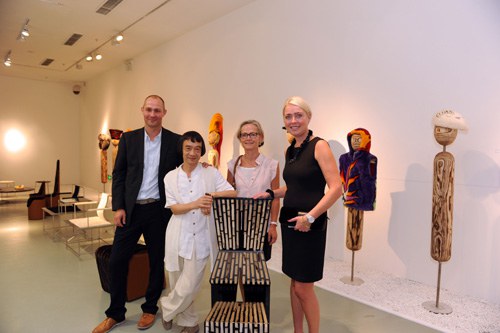|
 |
|
JOINT WORK: Zhu Xiaojie (second left) poses before the chair he co-designed with Danish designers (GONG DI) |
Magnificent and elegant Chinese furniture decorated the major venue for this year's APEC meeting hosted in Beijing—the International Conference Center in Huairou District. Wooden tables and round-back armchairs were arranged in a circle, surrounded by screens, radiating the charm of China's culture and the wisdom of its designers.
Round-back armchairs are quintessential Chinese. "Every chair was tailor-made," boasted Li Hong, who heads a business division of BBMG Tiantan Furniture Co. Ltd., a major furniture supplier for the Beijing APEC meetings.
Li said that the chairs were specially designed to fit the leaders' individual figures so as to make the occupants comfortable.
Yet these armchairs differ from traditional ones in that they are installed with foot rests and hidden wheels. The position of the foot rest can be adjusted according to a leader's need to make him or her more comfortable, and the wheels made the mahogany chairs, each of which weighs more than 10 kg, more mobile.
It takes at least half a year to make such a chair. "Special crafts were employed to prevent the mahogany from cracking in dry air," said Yang Jincai, General Manager of BBMG Tiantan Furniture Co. Ltd.
Yang said the chairs were coated with natural wax, which forms a protective film on timber, and varnished with an odorless, non-toxic, water-based finish.
"The curved wooden screens, chairs and other pieces of furniture are all very impressive," said Chen Shengqiang, General Manager of BOL Furniture Co. Ltd. in south China's Guangdong Province.
Chen is particularly impressed with the two mahogany wooden relief murals in the main ballroom of the International Conference Center. The two murals, which are each 15 meters long and 4.5 meters tall, feature plum blossoms carved using a variety of complex and intricate woodworking techniques. The five petals of every flower represent joy, happiness, longevity, success and peace. The flowers, either depicted budding, half open or in full blossom, are neatly outlined and arranged. While decorating the conference room, they also added another element of Chinese culture to the venue.
"Behind every piece of art work are a good number of designers and artisans," Chen said.
Chen himself is a furniture designer as well as a business owner. He believes that designers are the core of a furniture business. His company attaches particular importance to hiring and training furniture designers, and offers them pay and status that match their value.
But things do not work well for quite a number of designers because many companies do not want to spend much money and efforts in designing and development, and their innovative efforts are often not adequately rewarded, Chen said.
The furniture industry is plagued by plagiarism, Chen lamented. Nonetheless, he said that his confidence in the space for innovation has increased after Premier Li Keqiang stressed that the government will dole out more severe punishments for infringements of intellectual property rights during the Eighth Summer Davos Forum held in Tianjin from September 10-12.
Chinese furniture was once internationally reputed, yet in recent years, it gave people the impression that it is low in creativity, cost and added value. The domestic furniture industry is striving to earn more international recognition. In 2012, Chinese furniture producers and designers debuted at the 50-year-old Milan Furniture Fair, one of the most prestigious events for furniture artisans, in the capacity of exhibitors, and gained a lot of attention with their original designs.
About 80 chairs designed by more than 50 Chinese designers were displayed in the Slow Seating—Contemporary Chinese Design exhibition, which was part of the Milan Furniture Fair. Corriere della Sera, the most circulated magazine in Italy devoted one whole page to reporting the emergence of Chinese contemporary design on the international stage.
Zhu Xiaojie, Deputy Director of China Furniture Design Committee, said the Milan Furniture Fair is one of the three important design exhibitions in the world and the weather vane of global design trend, and Chinese producers and designer's performance at the fair would help change the stereotyped image of Chinese design.
| 